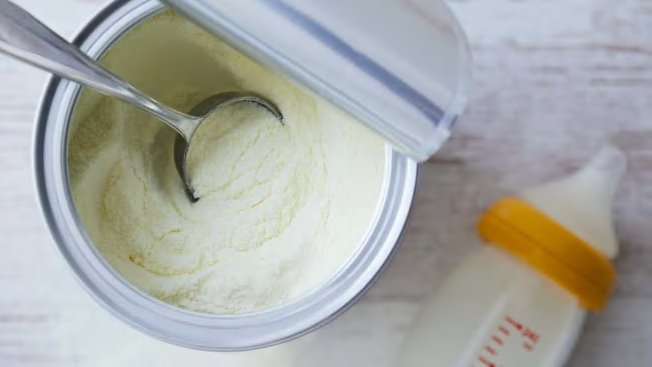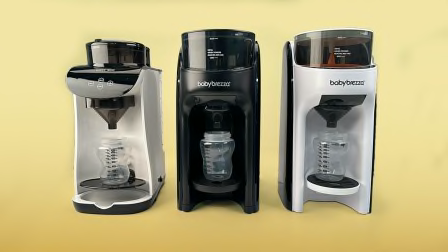How to Safely Switch Infant Formulas
Needing to switch formula can be stressful, but here are tips to make the transition easier

Switching your baby’s formula from one brand to another, whether because of a formula recall, supply shortage, cost, intolerance, or allergy, can be stressful. Babies’ developing digestive systems can seem delicate and more sensitive to big changes. But most babies do fine switching between formula brands when needed, according to the Centers for Disease Control and Prevention.
- Switching Infant Formula: What to Know If You Have to Switch 5 Tips for Making the Switch Easier Formula Intolerance Signs to Watch For
What to Know If You Have to Switch Infant Formula
When you’re considering making the switch to a new infant formula, it’s good to know that all infant formula sold in the U.S. is tightly regulated and subject to strict safety and nutrition requirements as outlined by the Food and Drug Administration. Recalls can happen, but they are usually rare.
Each formula also must demonstrate through a clinical study that it supports “normal infant growth,” and must provide the necessary carbohydrates, fats, protein, vitamins, and minerals a full-term infant needs in the first year of life, with the addition of solid food starting at six months. All formulas must meet strict nutrition standards to ensure that they contain all the necessary nutrients for your baby’s healthy development. To help you narrow down your choices, here’s what to know.
If You’re Switching Because of a Recall or Shortage: Start by Matching Macronutrients
If your baby was doing well on their previous formula and you’re looking for a similar replacement due to cost, availability, or a recall, your best bet is to try to match the primary ingredients between your new and old formula. At least 98 percent of what’s in the formula are the macronutrients (carbs, fats, and protein), says Young. These are the primary sources of calories your baby needs, and where formulas tend to differ the most.
Micronutrients (vitamins and minerals, for which the FDA dictates minimum and/or maximum levels in formula) make up the other 2 percent, alongside any added ingredients included to mimic breast milk, what Young calls “sexy extras.” These ingredients, such as DHA, prebiotics, probiotics, and nucleotides, are not required and tend to have less concrete research supporting their use in infant formula. Read more about these ingredients in our baby formula buying guide.
“Look for a new formula that has the same protein and carbohydrate source as your previous formula,” says Young. “The easiest way to do this is to try to match the first few ingredients of your old formula with your new formula.” As an example, if your current formula uses lactose and whey protein as the primary ingredients, seek out another formula that also lists lactose and whey protein first on the nutrition label. Matching up the formula base will hopefully help your baby have a smoother transition.
If You’re Switching Because of a Digestion Issue: Start by Switching Protein Type
If your infant is having trouble tolerating their previous formula, switching the protein source (such as transitioning from a cow’s milk base to a goat’s milk base) or type (trying partially hydrolyzed proteins) may help. Focus on the protein rather than the carbohydrates, as it’s a common misconception that babies can’t digest lactose—most infants are born with the ability to digest this type of milk sugar, which is the main source of carbohydrates in breast milk. “Lactose intolerance in adults is common, but incredibly rare in infants,” says Young.
First, check in with your pediatrician for a recommendation before making a switch, and ask them about trying a partially hydrolyzed infant formula, which has partially broken-down proteins that may make it easier for babies to digest. Young says that research shows they may be especially useful if your baby is dealing with eczema. “However, they are not universally recommended, as most babies digest standard formulas made with intact proteins just fine,” she says.
Goat’s milk-based formulas are growing in popularity as an alternative to cow’s milk-based formulas, and feature a different type of protein structure that works well for some babies. Just note that goat’s milk formula may not be a solution for infants diagnosed with cow’s milk protein allergy, given the similarities between cow’s milk and goat’s milk proteins. Talk to your pediatrician about formula options that are safe for babies with CMPA.
Soy-based formulas may be recommended for babies with allergies to animal milk proteins, but speak with your doctor about whether it’s the right choice for your little one. Your pediatrician is your best resource when it comes to specific questions about your baby’s feeding and nutrition.
If You’re Switching Because Your Formula Is No Longer Affordable: Consider a Store-Brand Formula
In truth, brand-name and store-brand infant formulas don’t differ dramatically in terms of ingredients, and buying a store-brand formula can save you money. Many store-brand infant formulas are made by the same manufacturer, Perrigo, and their formulations have all met the same standards. Store brands are also identical from store to store, says Young. “This means that one store brand’s ‘Gentle’ formula is exactly the same as another store brand’s ‘Gentle’ formula,” so you can comparison shop between stores for the best price.
See the formulas that came out on top, including several store brands, in CR’s testing of infant formula for contaminants.
5 Tips for Switching Baby Formula
Ready to make the switch? Here are tips for a smoother transition.
1. You Don’t Need to Transition Gradually
There’s no need to transition formulas gradually—and you may not even have that luxury, especially if there’s a recall alert with your baby’s current formula or if your baby is showing signs of allergy or intolerance (more on this below).
If you need to go cold turkey, it’s totally fine to start by offering your baby the new formula right away. Alternatively, you can start by mixing in a bit of the new formula into your baby’s old formula, which helps to slowly introduce your baby’s intestines to a new food, Young says.
“There’s no right or wrong here,” says Young. “I do usually recommend that if you’re exclusively formula feeding, it’s a more gradual introduction if you do mix [some old and new formula].” Young says to mix prepared liquid formula, not scoops of the powdered base: “Make the bottles separately and mix the final volumes together,” she says. You might start with 75% old formula and 25% new formula, then slowly change the dilutions to more new formula over a few days.
2. You Can Start the New Formula at Any Feed
There’s no magic time of day that’s best to start a new formula—you can start at any time that works well for your family. “There’s no wrong time of day to start a new formula, so don’t worry about it,” says Young. That said, it can help to find a “sweet spot” in the day when your baby is hungry but not fussy before offering a new formula. For some, that’s likely to be the first morning feed.
One additional advantage to offering a new formula with the first feed of the day: Starting earlier in the day can be helpful to spot any potential reaction signs. “This way, if a reaction does develop, it is not in the middle of night,” says Young.
But since there’s no right or wrong time to begin, you can start a new formula at any time. “Don’t panic. If [parents] want to start when they come home from work because they’re the ones at home and not a caregiver, wonderful! That’s totally fine,” Young says.
3. Monitor Your Baby’s Digestion
Whenever you introduce a new formula or baby food, it’s essential to monitor their digestive system for up to 10 days for any changes that indicate how they’re processing the change.
A new formula can cause an increase in gas and spit-up, or may result in loose or firmer stools, or a change in stool color or odor. Some gas, spit-up, and mild stool changes are normal for a week or so after changing formula, but worrying signs like forceful vomiting or bloody stools are possible signs of formula intolerance or an allergy that should be addressed with your doctor (more symptoms to watch for listed below).
“I often tell parents to keep a symptom diary,” says Young, who recommends taking pictures of any rashes you spot, or spit-up if it has you worried. “And at the end of the day, rate the day,” she says. “Even on a scale of 1 to 5, with 5 being ‘we were up all night’ and 1 as ‘we had the best day ever.’” Over the course of a week, you can then more easily spot the gradual shift in symptoms or tolerance—and you have more concrete observations to share with your pediatrician, if needed.
4. Keep Other Routines Consistent
In an effort to minimize the changes your baby is experiencing, try to keep feeding, nap, and sleep routines consistent as much as possible. Introducing other new factors into the mix when you’re switching formula can make it hard to pinpoint the true cause of any issues that may arise. Is your baby crying more because they’re overtired, or for another reason? Aiming for consistency can help you rule out other potential reasons your child might be showing new signs or symptoms.
5. Be Patient
Your baby might not fully accept their new formula right away—which is completely normal. Try to stay patient and keep offering it to them—acceptance of a new formula can be slow. “This is where starting off slow and gradually can help, especially if you do have a big taste difference,” says Young, like when you’re going from a cow’s milk base to a goat’s milk base. But if you’re dealing with a recall or an allergy and don’t have the option of a gradual, slow-and-steady approach to a new formula, talk to your pediatrician for more advice on how to encourage formula acceptance.
Symptoms of Formula Intolerance to Watch for When Switching Baby Formula
If your baby is having trouble digesting their formula, they may show the following signs:
• Excessive crying or fussiness after feeding
• Loose, watery stools
• Eczema or rashes
• Wheezing
• Extra tiredness or extreme fatigue
• Weakness
• Forceful vomiting
• Blood in stools, which can either look red or have black particles in the stool
Look for any moods or symptoms that might be uncharacteristic for your baby. Anything out of the ordinary should be brought to your doctor’s attention, who can help you navigate the next steps. “Anytime you are worried about a symptom, or worried if something even is a symptom, call your doctor,” says Young. “Remember, your pediatrician works for you, and they want to hear from you!”




















